You’ve probably heard that Google Ads drains SaaS budgets. So why do so many SaaS companies still use them?
The reason is simple: when done right, Google Ads can drive meaningful results and deliver real business growth.
From the keywords you target and the bids you set to the landing pages your ads lead to, every element plays a role in determining performance. Small adjustments, like refining a headline, selecting the right match type, or tweaking your budget, can make a huge difference.
We understand that you want to avoid wasting ad spend while figuring out what works. That’s why we’ve created this guide on the best practices for SaaS Google Ads.
Why Google Ads for SaaS Is Essential in 2025
Google Ads is a one-of-a-kind advertising format that works with intent-driven targeting, meaning it shows your ad to people who are already searching for a solution like yours.
People normally hate ads. They instinctively close them and get back to their original mission, but not when they find exactly what they were looking for.
Your ad doesn’t interrupt the scroll. It appears as just another search result for the query the user has already typed in.
That alone is a big win. You get hot leads delivered straight to your doorstep. Especially in SaaS, where buying cycles are long and purchases are rarely impulsive, this type of advertising can save you a lot of money and time.
Here, the PPC model has its own advantages: you pay only for the clicks you get. No clicks, no charge, no wasted budget.In 2025, Google still dominates with over 79% of desktop searches and more than 95% of mobile searches. Choosing this platform to capture the attention of potential customers is still a must-have marketing strategy for SaaS businesses.

Google Ads Formats That Work Best for SaaS Companies
Most of the time, we recommend these approaches to our B2B SaaS clients, as we’ve seen them consistently outperform other strategies:
- Google Ads Performance Max Campaigns (PMAX)
- Display Ads for Remarketing Campaigns
- YouTube & Demand Gen for TOFU Campaigns
Search Ads for High-Intent Traffic
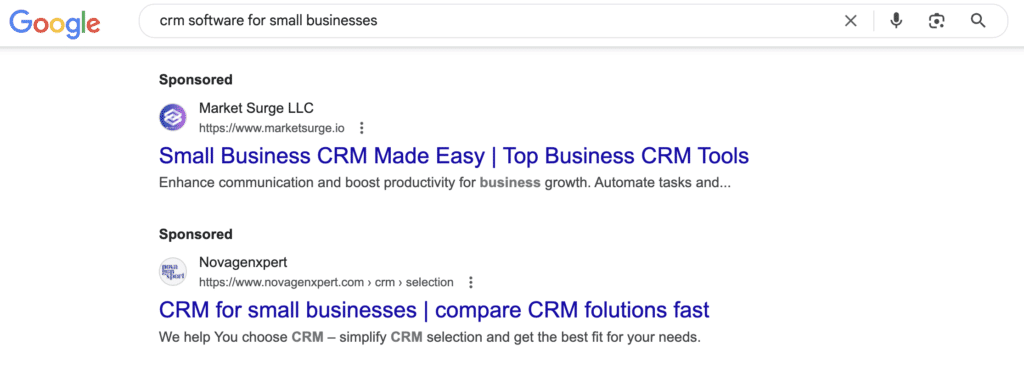
65% of ad clicks include buyer-intent keywords (like subscribe, buy, save, etc.), and you’re 30% more likely to get clicks if your ad matches the audience intent.
Why do we recommend this approach? Because when you target high-intent keywords, you capture users who are ready to take action. In other words, you’re not generating demand or waiting for your audience to reach the consideration or decision stage, you’re reaching people actively searching for a solution like yours.
Google Ads Performance Max Campaigns (PMAX)
Google PMAX is about 22% higher conversions and 20% lower CPA. That’s because Google’s advanced AI system adjusts bids and placement across platforms to reach the best-performing audiences.
All you need to do is upload your customer data, your creative assets (visuals, copy, headlines), and clearly defined goals (conversions or traffic growth).
Instead of running separate campaigns for each platform, PMAX combines everything and automatically delivers your ads across Google Search, YouTube, Gmail, Display, and Discover. And in Google Insights, you can always track performance and see what’s working in the Google Ads Insights tab.
Display Ads for Remarketing Campaigns

Retargeting campaigns have around 10x higher CTR than standard display ads, and 70% of users are more likely to convert after seeing a retargeting ad.
This is one of the most effective ways to stay top-of-mind during the long sales cycles typical in SaaS. While your potential customer is weighing their options, your retargeting campaign keeps reminding them of your product.
Customizing ads based on user behavior drives conversions. For example, we offer first-time purchase discounts to users who abandoned the check out page, or free trial extensions to those who tried the product but didn’t upgrade. That level of personalization can make a real difference in how your campaigns perform.
YouTube & Demand Gen for TOFU Campaigns
Google reports that 63% of users discover new products via Google feeds and 91% of them take action right away. That’s why YouTube and Demand Gen (advanced version of Google Discover) are go-to channels for TOFU campaigns, where the goal is to build awareness and spark early interest.
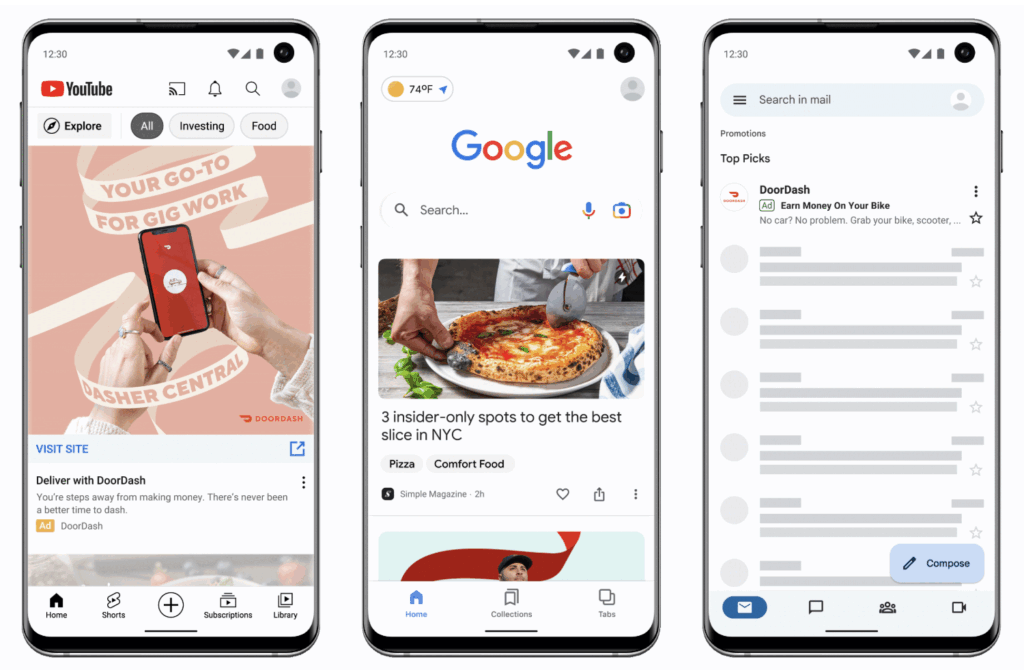
For example, a blog-style ad can appear in a user’s feed, introducing your brand and solution in an engaging way. This format works well for targeting users actively consuming content related to your category. And when Demand Gen added more features to Google Discover (access to YouTube shorts, image and video ads in one campaign, etc.), you have more chances to get qualified leads for SaaS.
YouTube skippable ads are equally powerful. 59% of users say YouTube ads feel more relevant than those on TV or other streaming services. A short, well-made video can be enough to drive them to your site.
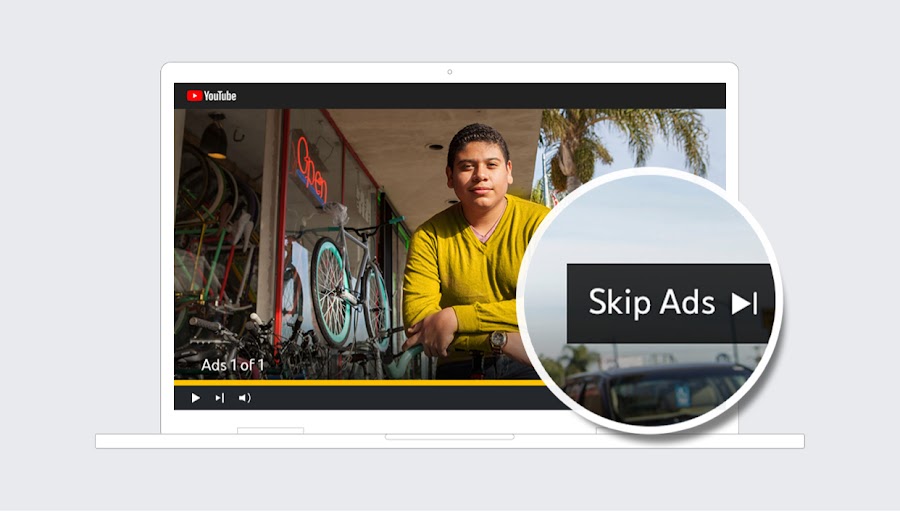
How to Track SaaS Growth Through Google Ads
When running Google Ads for B2B SaaS, tracking performance is everything. Since this is a trial-and-error game, the best way to improve your results is to analyze real data from your previous campaigns and let it guide your next move.
Yes, Google Ads provides valuable metrics like CAC, CLV, churn rate, MRR, SQLs and so much more, but they only tell part of the story in b2b saas marketing.
That’s why we always add two more layers of information for tracking accuracy:
- Offline Conversion Tracking (OCT)
- Metric alignment with funnel stages
OCT helps us track what happens after the click in the offline world, like demo bookings, sales calls, or signed deals. Since Google can’t track those by default, we sync this information back to Google Analytics ourselves to complete the picture.
To do this, we capture the Google Click ID (GCLID) during the ad click, connect it with CRM activity, and sync those offline events back to Google Ads.
Additionally, we evaluate the metrics in the context of sales funnel stages that the ads are designed for. For example, TOFU campaigns aren’t expected to convert immediately, they’re meant to attract and educate. That’s why it’s not alarming to see low conversion rates for TOFU campaigns.
Instead, we focus on early indicators like click-through rate (CTR) and cost per click (CPC), as these indicate the success of the ads in capturing attention and driving traffic to your website.
Best Practices to Turn Google Ads for SaaS into MRR
MRR growth in SaaS doesn’t come from more traffic but from better systems that convert traffic into qualified leads. Here are our cherry-picked steps we rely on to make that happen:
Define Your SaaS Metrics
All the metrics you track from your Google Ads performance should answer one core question:
Is the ad budget you spend on bringing in customers really worth it?
This means answering several questions:
- How much does it cost to get a customer?
Customer acquisition cost (CAC)helps you identify which type of SaaS ads are more cost-effective for you (where you spend less but get more value).
- How long do those acquired customers stay with you? (Customer and Revenue Churn Rate)
With customer churn rate, you see the percentage of customers that cancel your subscription service within a set time frame. On top of that, the revenue churn rate shows you the percentage of recurring revenue you lost in a certain period (e.g., customers reducing their plan).
- How much revenue a customer brings in over time?
The customer lifetime value (CLV) shows how much revenue you earn from a single customer throughout their entire journey with your SaaS. It can help you understand how much revenue you can expect from a customer in the long run and plan your ad strategy accordingly.
By combining these metrics, you get actionable insight.
If your CAC is high but your CLV is even higher and churn is low, you’re on the right track, you’re bringing in valuable customers, even if they cost more upfront.
But if CAC is rising while CLV drops or churn creeps up, it’s a sign to rethink your targeting, offer, or ad messaging.
Build High-Converting Landing Pages
Google says effective landing pages play a vital role in converting your Google Ads traffic. And an effective landing page is one that includes exactly what the viewer is looking for and without distractions.
Clear, straight to the point and with excellent navigation is the all-time formula for a converting landing page.
Here are some stats to help you prioritize the right things on your landing pages:
- Google says effective landing pages play a vital role in converting your Google Ads traffic. And an effective landing page is one that includes exactly what the viewer is looking for and without distractions.
- Clear, straight to the point and with excellent navigation is the all-time formula for a converting landing page.
- Here are some stats to help you prioritize the right things on your landing pages:
- Median landing page conversion rate for SaaS is 6.6%. You can use this benchmark when measuring your performance.
- Since web visitors spend 57% of their viewing time above the fold of your landing page, it means your title, description, and CTA at the top matter most.
- 38.6% of marketers claim that video is the top factor in boosting conversions. which means a short demo or intro video can go a long way.Personalized CTAs perform 202% better than generic ones. So make sure your CTA promises what your target audience needs most (e.g. “Get your free consultation”, ”Download the full guide to social media marketing”).
- Lastly, simple landing pages without a navigation menu can double conversion rates. Adding more white space and simplicity to your landing pages means fewer distractions, clearer action.
Create a Funnel Strategy
Converting your audience doesn’t happen overnight. Many people who click your ad have never heard of your brand before. So don’t worry if the Google Ad reports show a high new visitor percentage with low conversions.
With regular, well-thought-out touchpoints, you gradually build awareness, trust, and interest in your product.
Create touchpoints at TOFU: Top of the funnel ad strategy is not about conversions. Your goal at this stage is to evoke interest, increase brand awareness, and stick in your target’s minds so that users return to explore your brand further.
A characteristic of this stage is that you usually deal with high-volume keywords (those with high monthly search volume) that have lower Cost per Click (because they are less likely to lead to immediate sales).
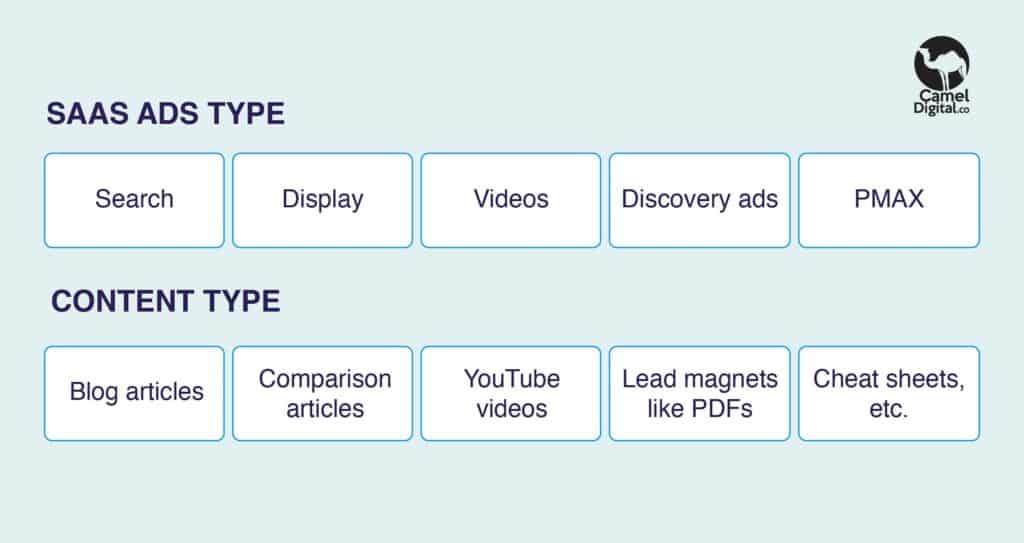
Become friends at MOFU: It’s high time to strengthen connections based on the awareness you’ve already built. At this stage, the audience knows who you are, but they’re still exploring their options.
The tactics that are proven to work at the middle of the funnel strategies are remarketing and tying your audience with lead magnets. You can retarget your website visitors by understanding their intent from their visited pages.
For example, if they visit your service page, you can retarget them with a detailed cheat sheet on using your service to achieve specific results and invite them for a free demo.
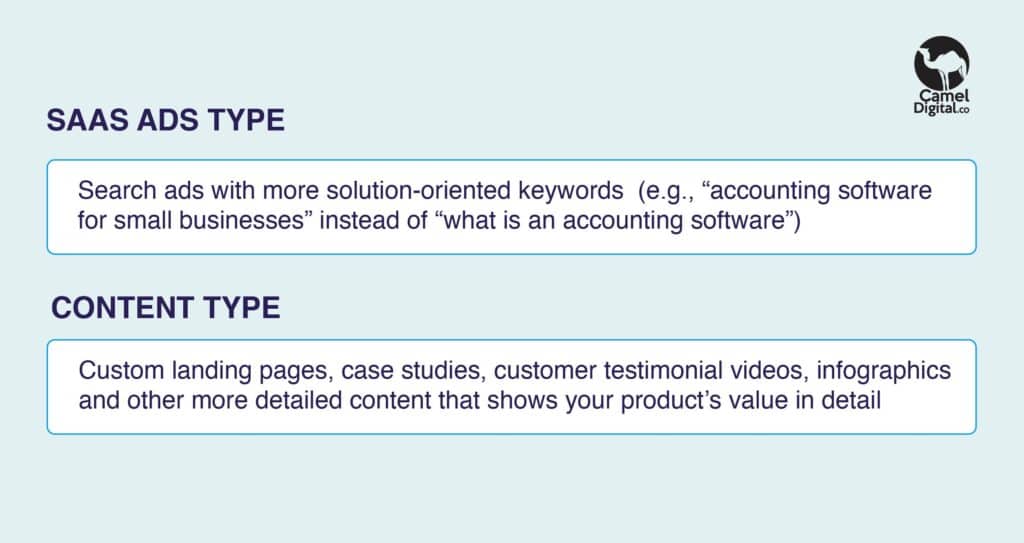
Sell at BOFU: Note, you’re not done in the bottom of the funnel stage, you’re ALMOST done. This is one of the crucial stages where you should help your audience cross the finish line with good offers, discounts, and incentives.
Here, you should focus your Google Ads strategy for SaaS on high-intent keywords, such as terms having the “tool”, “software”, “solution” or similar in them. It’s also the best stage to play with competitor alternative keywords – like “HubSpot alternative”, etc.
You should remember that fighting in the battle for high-intent keywords means being fiercely competitive. At this stage, you need concise and short landing pages – really no extras, no distractions. Just a short, selling copy, clear descriptions, and very captivating design.
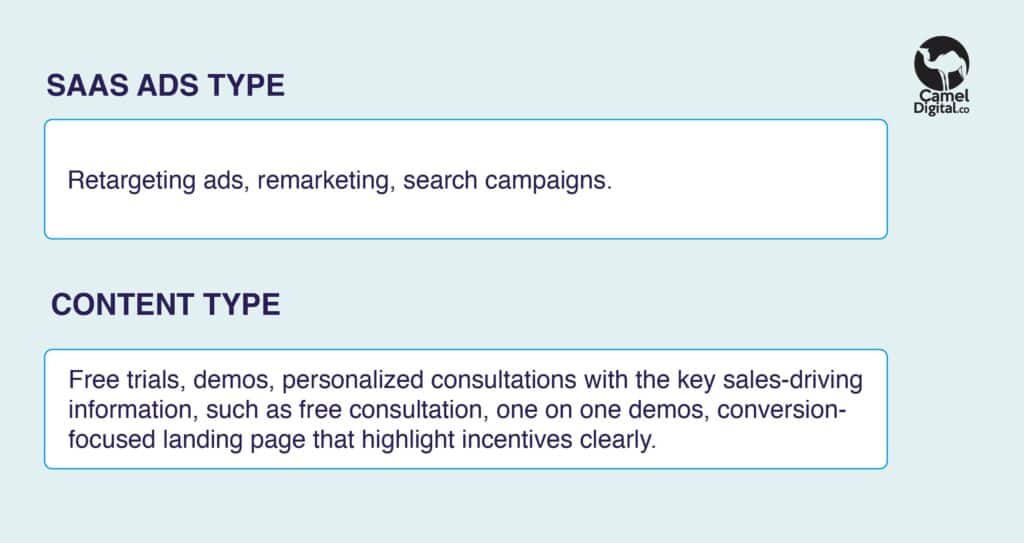
Use Automated Bidding Strategies
Automated bidding in Google Ads uses real-time data and smart algorithms to help you by making bidding easier. These three strategies are especially effective for SaaS campaigns:
- Maximize Conversions with Target CPA: This helps get more conversions within your set cost per acquisition (CPA).
- Smart Bidding: Uses machine learning to automatically adjust bids based on performance data, optimizing for conversions.
- Target Impression Share: Helps ensure ads show in prominent positions (e.g., top of the page) to increase visibility, typically in competitive markets.
- Maximize Clicks: Aims to drive as many clicks as possible within the set budget, often used for driving traffic during the awareness phase.
- Maximize Conversion Value: Optimizes for driving as much conversion value as possible (e.g., premium subscriptions) within the budget.
These strategies save time and improve results by automatically adjusting your bids based on performance signals.But they work best when you have enough historical data, and they still require regular monitoring. Otherwise, your budget can end up going toward the wrong keywords.

Real Results with Google Ads for SaaS
At Camel Digital, we don’t do everything. But Google Ads for SaaS companies, we do really well. You can trust our SaaS PPC agency because we’ve spent years learning what actually works in this space, through real projects, real budgets, and lessons you only get from doing the work.
Here’s how we helped SaaS companies achieve a 367% increase in brand awareness, resulting in 73.33% more website leads.
If you want your success story to be next, request your free proposal now.
Frequently Asked Questions
Does Google Ads work for SaaS?
Yes, Google Ads can be highly effective for SaaS companies. With targeted campaigns, you can reach potential users searching for specific solutions. This allows you to drive qualified leads and conversions. It also opens the way for accurate keyword targeting, audience segmentation, and budget control, making it a great tool for growing your SaaS business.
How do I run ads in SaaS?
To run ads for SaaS, start by defining your goals (such as lead generation or user sign-ups). Then, carry out keyword research to find relevant terms and create targeted ad campaigns with compelling offers. You can then use Google Ads’ tools for audience targeting. Keep optimizing your ads by monitoring performance, adjusting bids, and refining keywords to maximize your ROI.
Do Google Ads work for service businesses?
Yes, Google Ads works well for service businesses. By targeting relevant search terms, service businesses can reach potential customers actively looking for solutions. Google Ads helps boost visibility, drive traffic, and generate leads with a pay-per-click model, making it ideal for businesses that provide various services, including SaaS.
